April is Sjögren’s Awareness Month
Sjögren’s is one of the most prevalent but still lesser known autoimmune diseases. It is also not a “cookie cutter” disease and affects patients differently. This can lead to a misunderstanding about the seriousness of the disease and be extremely isolating for those living with it.
Using our new 2020 theme, we are going to expand our #ThisIsSjögrens online campaign. We will post every day in April, using one or more of our social media channels, to create a better understanding of the disease. While the daily posts will each give one small glimpse into living with Sjögren’s, by the end of April, we hope these 30 posts will help others visualize the vast impact of the disease. Click here if you would like to learn how to be one of our highlighted stories in April.
Help us conquer the complexities of Sjögren's this April because every day is an opportunity to start a conversation about Sjögren’s and how it affects you. The more others understand, the more support you can find.
Ways you can get involved:
Together we will conquer the complexities of Sjögren's!
30 Days of Sjögren's Awareness
Day 1:
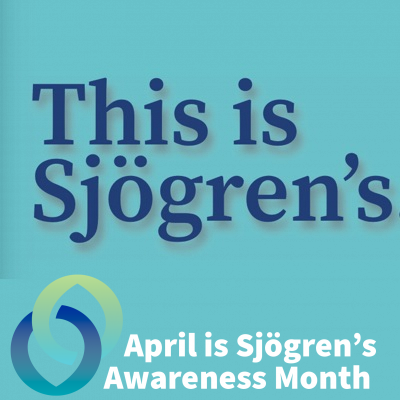
April is Sjögren’s Awareness Month. Today, we invite you to update your Facebook profile picture with our Awareness Frame to help raise awareness of this complex and misunderstood disease. In today’s healthcare system, especially amid the COVID-19 crisis, it is even more important that we virtually come together to ensure that Sjögren’s patients are not forgotten.
Sjögren’s (SHOW-grins) is a systemic autoimmune disease that affects the entire body. Along with symptoms of extensive dryness, other serious complications include profound fatigue, chronic pain, major organ involvement, neuropathies & lymphomas.
Day 2:
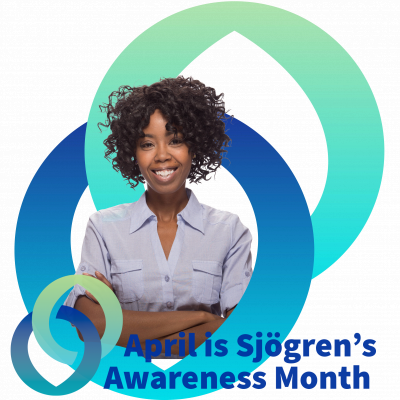
It is with great pride that during Sjögren's Awareness Month, the Foundation can announce that we have officially changed our name, our logo, our look and our website! We have been asked for years to drop the word "syndrome" from our name and literature, and after a year-long project working alongside our board, medical & scientific advisors, patients and volunteers, we are excited to share with you our new logo and newly designed and rebranded website - www.sjogrens.org.
Day 3:
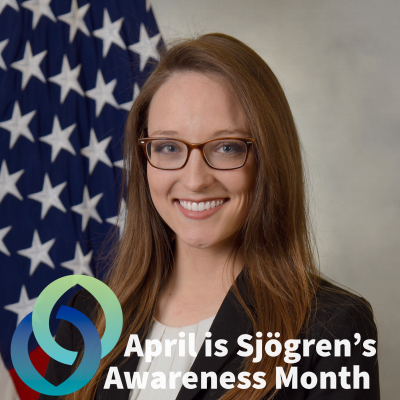
Katie 25 (diagnosed at 20)
My most difficult Sjögren's symptom that people don’t understand is fatigue. It’s not being tired. It’s your muscles refusing to work, your legs refusing to carry you around and your arms refusing to be raised up. Some people with Sjögren's will wake up with this fatigue, some develop it after a busy or stressful day, and for others, it hits us like a brick out of nowhere. We aren’t being lazy. It can be paralyzing. Click here to learn more about Sjögren's fatigue.
Day 4:
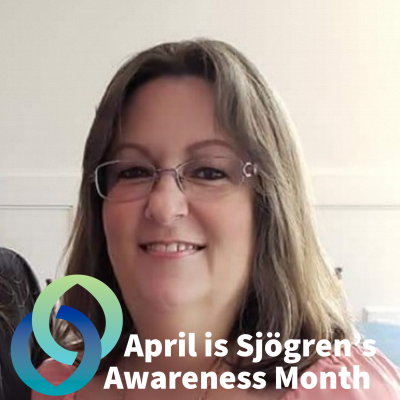
Kathy 55 (diagnosed at 53)
My most difficult Sjögren's symptoms are neuropathy, difficulty breathing, frequent bronchitis, extreme fatigue, hair loss, dry itching skin, and muscular/joint pain.
I wish that people knew that being handicap can look different. People stare when they see me with my handicap placard and I’d like them to know that it’s not because I can’t walk, it's because my lungs won't let me walk long distances. Click here to view from our Living with Sjögren's survey Summary of Major Findings.
Day 5:
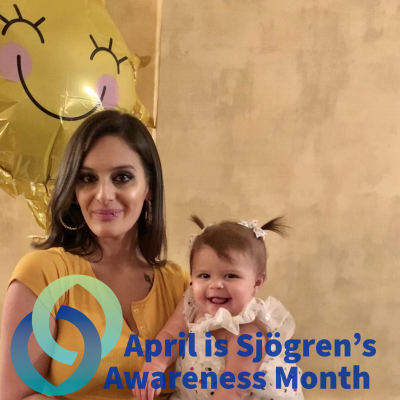
Alyssa 29 (diagnosed at 16)
I truly felt the effects of Sjögren's when I became a mother. Despite a high-risk pregnancy because of Sjögren's antibodies, I now have a healthy, active toddler who I desire to keep up with.
I wish people knew that even though I always smile and seem like an active person, there are days where I am pushing through fatigue and joint pain. My best advice is to stay hydrated, bring awareness and try to have a positive mindset through it all.
Click here to learn more about pregnancy and Sjögren's.
Day 6:

Melissa 44 (diagnosed at 37)
When I was diagnosed with Sjögren's, my first thought was, what is Sjögren's? I had never heard of the disease. After my initial shock, I had had so many questions for my rheumatologist. I believe that when we are diagnosed with Sjögren's, we have a responsibility to educate others. We have to keep fighting.
Click here to learn more about living with Sjögren's.
Day 7:
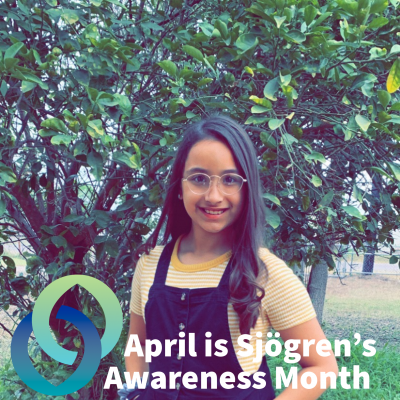
Jaeden 10 (diagnosed at 6)
I’m a kid that just wants to have a normal life. When I’m out with friends or family the extra breaks and carrying around extra water gets annoying. I wish more people and schools were more educated on Sjögren’s to understand me better. This is something that isn’t going away and every day is different.
Click here to learn more about Sjögren's in children.
Day 8:
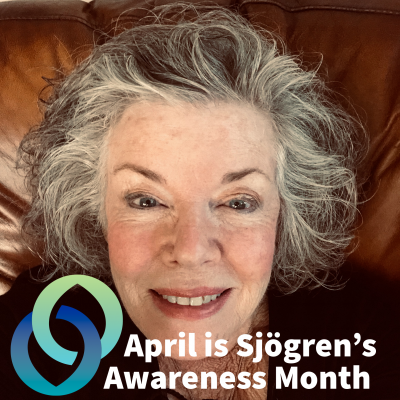
Sherry 72 (diagnosed at 72)
I was recently diagnosed with Sjögren’s from a lip biopsy, after my serum test were always negative. I’m thankful to finally have a diagnosis because my various symptoms like neuropathy and dry skin make sense, but my diagnosis is new and due to COVID-19, I can’t see a rheumatologist until medical offices are opened again.
Click here to learn more about how Sjögren's is diagnosed.
Day 9:

Abby 22 (diagnosed at 22)
My most difficult Sjögren’s symptoms are fatigue, frequent fevers and a painful malar rash on my face. My rheumatologist suggested I try a restrictive autoimmune protocol diet, which helped me learn what foods trigger me and my symptoms.
Click here to view the Foundation’s Book Store and view more Sjögren’s resources.
Day 10:
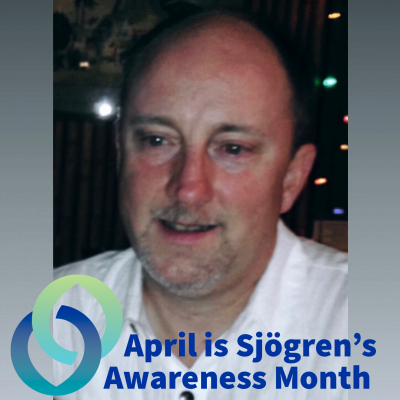
Ray 55 (diagnosed at 43)
Since I was diagnosed with Sjögren’s, I have learned that I can still be me and enjoy my life! My most difficult symptoms are peripheral neuropathy, fatigue, dry mouth and dry eye. I cope with this disease by taking “me” time when I need it, medication as directed by doctor, and keeping my medical appointments. My best advice is to set personal goals and keep them, but don’t overdo it. Click here learn more about Sjögren's in men.
Day 11:
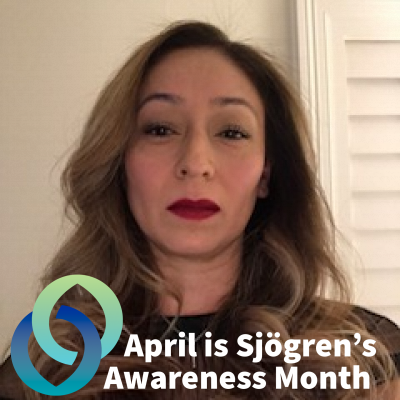
Ana 43 (diagnosed at 23)
I wish people understood that just because I look "normal," internally, I am fighting a battle with a multi symptom disease.Every day is a struggle to gather energy and live a life, as best as I can.
Click here to learn more about Sjögren’s symptoms.
Day 12:
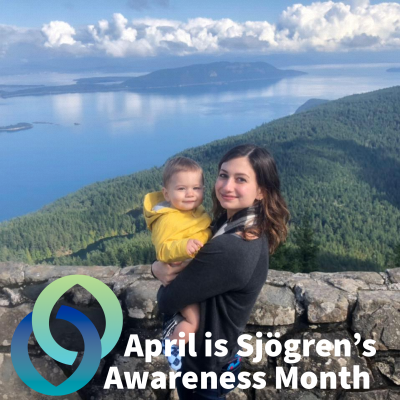
Katie 31 (diagnosed at 28)
Sjögren’s is so much more than dry mouth and dry eye. There is no roadmap for how the ugly symptoms can present themselves. I wish people took this disease more seriously. It can be so painful and isolating.
Click here to learn more about Sjögren’s.
Day 13:
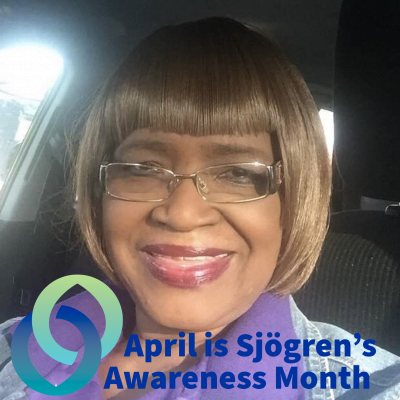
Betty 66 (diagnosed at 55)
I first went to my doctor because I had a charley horse one night that was so bad, I couldn’t sleep. I went to my doctor who said my antibody was positive and then sent me to a rheumatologist who did a lip biopsy, which led to my diagnosis. I take my prescribed medications and have learned that I can live a normal life, but I am still in pain most of the time.
Click here to learn more about living with Sjögren’s.
Day 14:

Janell 55 (diagnosed at 26)
Sjögren’s means that I’m always at some type of doctor and wonder every day how I’m going to feel when I wake up. My best tip is to know your body and have a support system like a Sjögren’s Foundation Support Group.
Click here to learn more about Foundation Support Groups.
Day 15:
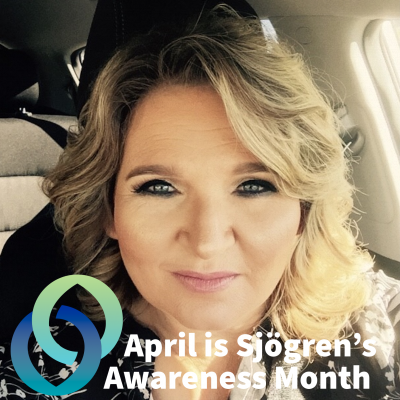
Laura 47 (diagnosed at 42)
My most difficult Sjögren's symptom is the tooth decay. I’m always aware and self-conscious of my mouth when I talk and try to cover it whenever I laugh. My biggest fear with COVID-19 is that there is an extended shortage of Hydroxychloroquine/Plaquenil and autoimmune patients become collateral damage.
Click here to learn more COVID-19 updates from the Sjögren's Foundation
Day 16:
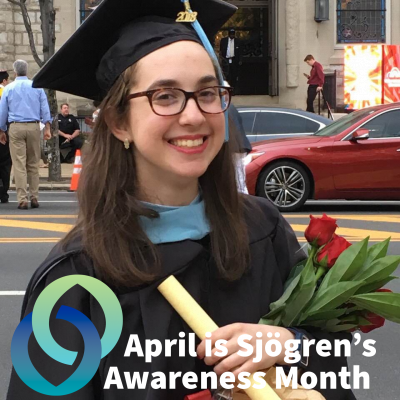
Joan 24 (diagnosed at 20)
Sjögren's has taught me how to be an advocate. I learned that I need to be my own best advocate in medical appointments, when I was in college, at work and I have learned that I need to be an advocate for all patients living with this disease. My best tip is to not take the good days for granted and when you’re having a harder time (in a flare) be kind to yourself. It’s okay to not accomplish everything on your to do list.
Click here to learn more Sjögren's tips.
Day 17:
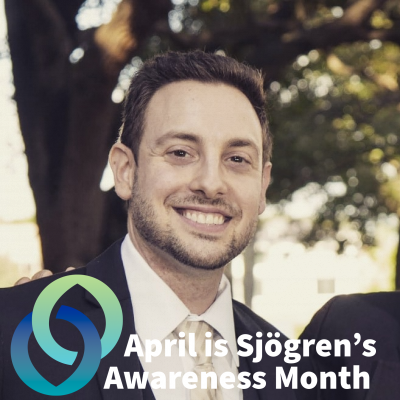
Chris 30 (diagnosed at 25)
Since being diagnosed with Sjögren's, I have learned that there is no right answer for this disease. Just when you think you have a symptom under control, something new pops up that you've never experienced. We are in this together!
Click here to learn more about becoming a member of the Sjögren's Foundation.
Day 18:
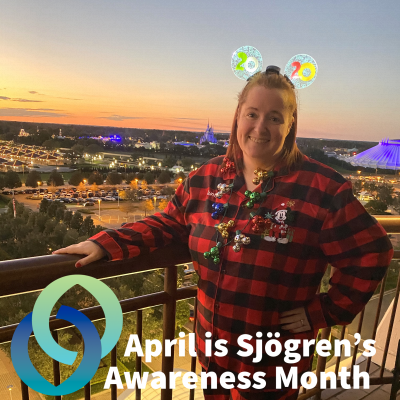
Billie 44 (diagnosed at 40)
Currently, I am medically quarantined per doctor’s orders. I have been hospitalized seven times for pneumonia illnesses in the past, including one time in the ICU. Sjögren’s taught me that I am tougher than I ever thought I was, but I am afraid for my safety if I were to contract COVID-19.
Click here to view the Foundation’s response to the Coronavirus.
Day 19:
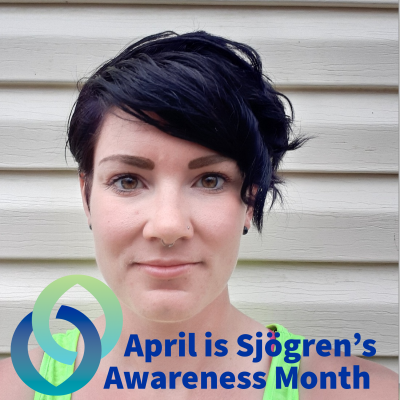
Emily 33 (diagnosed at 32)
My most difficult Sjögren’s symptoms are joint pain (especially in my hands), brain fog and fatigue. I love gardening and now I use assistive tools that make it more comfortable. I’ve found a lot of help in sharing tips and product suggestions with other patients.
Click here to learn more about how to get involved in the Sjögren’s Foundation community.
Day 20:
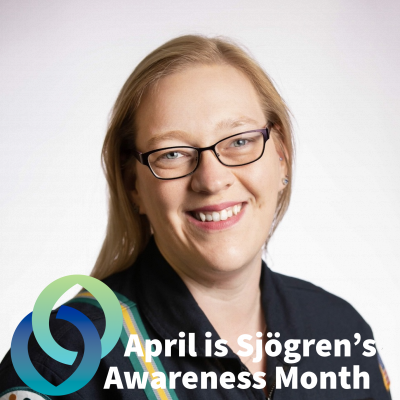
Johanna 40 (diagnosed at 39)
About a year before my diagnosis I noticed that I was chronically fatigued. I work long hours and brushed the symptom off, but it eventually got to the point where it was difficult to get out of bed. Being in the medical field, I knew something was wrong with my body. There are going to be dark frustrating days when living with disease. I encourage all of my Sjögren’s brothers and sisters out there to stay positive. Don’t ever give up!
Click here to learn more about Sjögren’s treatment options.
Day 21:
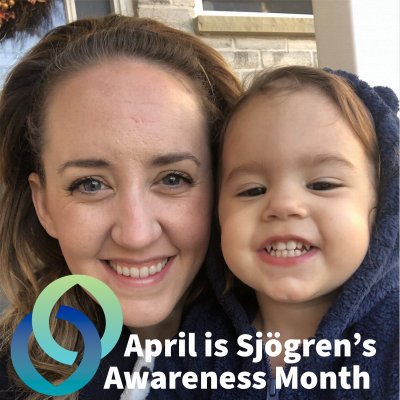
Amanda 30 (diagnosed at 28)
I was diagnosed with Sjögren’s after being hospitalized for 10 days (admitted for aseptic meningitis and uveitis). I find that so much is out of our control when living with this disease. My best tip is to find a really good healthcare team - don't settle! Your health is in their hands. It's important you feel like you're receiving current, compassionate and research-based care.
Click here to learn more information if you are newly diagnosed.
Day 22:
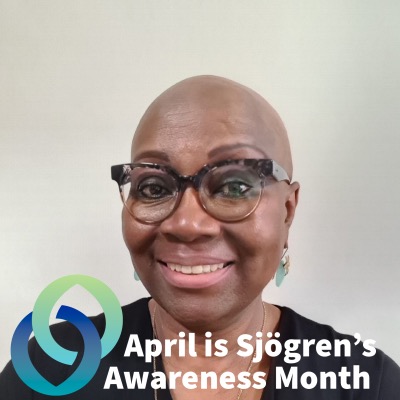
Inonge 58 (diagnosed at 54)
My most difficult Sjögren’s symptoms are chronic pain, fatigue, brain fog and body swelling. Due to scalp sensitivity, I’m unable to wear a wig and have been forced to accept the new me with alopecia. I have lost a lot because of this disease, which has taught me to focus on the things that really matter.
Click here to learn more about living with Sjögren’s.
Day 23:
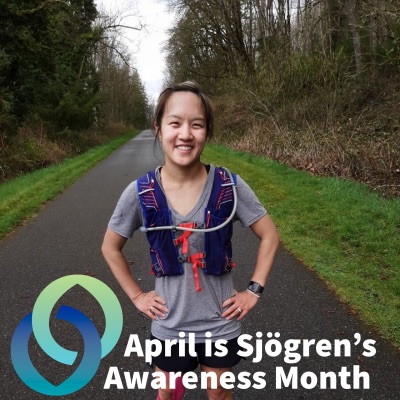
Jannalee 31 (diagnosed at 25)
I wish people knew that just because they can’t physically see the symptoms, it doesn’t mean we aren’t struggling. My best tip is that saying “no” is ok. People may not understand why I say no to certain events, but that’s okay. They aren’t living my life. If I overexert myself, I can’t function the next day and I don’t want to live like that. I want to embrace every day! Make time for things you enjoy and for me, that’s running.
Click here to learn more about the Foundation’s Team Sjogren’s Running Program.
Day 24:
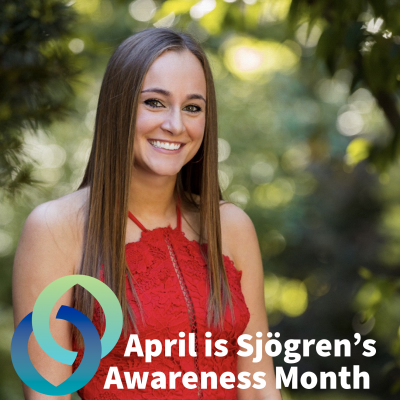
Kelsey 24 (diagnosed at 21)
My most difficult Sjögren’s symptoms include fatigue, widespread muscular and joint pain, dryness, neuropathy, hair loss, frequent colds, brain fog and vertigo. I believe that the largest misconceptions of Sjögren’s is the severity of this SYSTEMIC disease. It can affect every single system of the body and is different from person to person.
Click here to learn more about Sjögren’s.
Day 25:
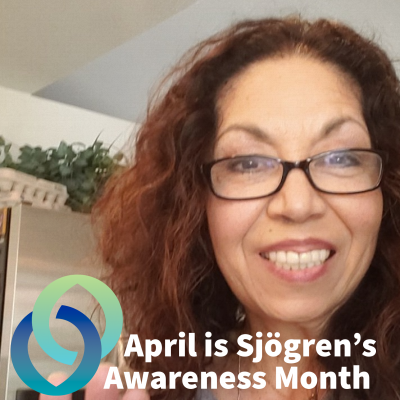
Susan 60 (diagnosed at 45)
It took me a while to be diagnosed with Sjögren’s because it can mimic other autoimmune disease. I wish people knew that when I speak and sound hoarse, it's because of Sjögren’s and not that I'm catching a cold or getting sick.
Click here to learn more about patient support town hall virtual meetings.
Day 26:
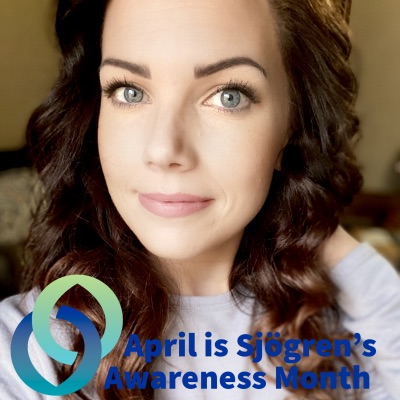
Tiffany 33 (diagnosed at 20)
My most difficult symptoms are chronic fatigue, inflammation, frequent headaches, vision issues, severe dry eyes, neuropathy, muscle weakness and pain. I wish people understood that going on a diet and getting more exercise is not a cure. Yes, those things can help but it’s not a cure. If it was that simple, I would have been cured a long time ago. Some days I feel pretty good and can handle my symptoms. Other days, I feel like I’m dying.
Click here to view frequently asked questions about Sjögren's.
Day 27:
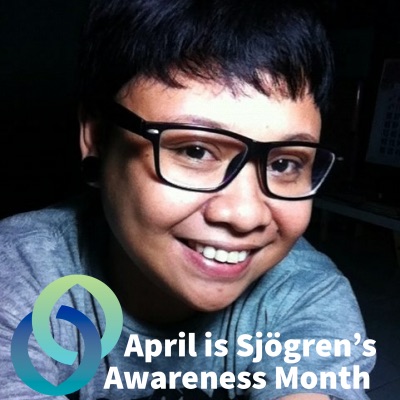
Ayyu 37 (diagnosed at 35)
I used to “power through” symptoms because I have a high pain tolerance, but Sjögren’s has taught me that I need to listen to my body. I have also learned to be kinder to myself both mentally and physically. A positive attitude is key.
Click here to view Sjögren’s Foundation resources.
Day 28:
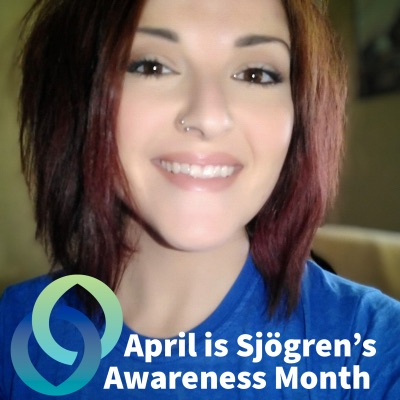
Trista 32 (diagnosed at 29 but symptomatic since childhood)
Sjögren’s means that you have to become your biggest advocate. I found that educating yourself is a necessity. One of my favorite resources is "The Sjögren’s Book" by Daniel J. Wallace.
Click here to learn more about "The Sjögren’s Book.”
Day 29:
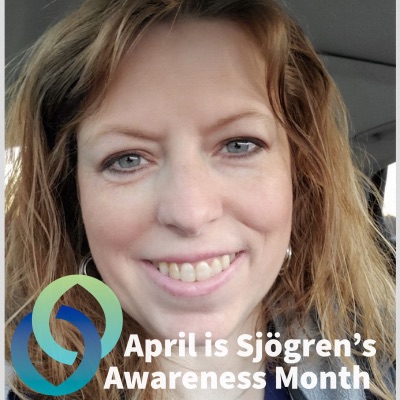
Tasha 46 (diagnosed at 5)
I was very sick as a child, but my parents taught me to be tough. My best tip is the advice I received from my father when I was 5. “You can do this. You can live with this.” Sjögren’s patients have to be strong. We can handle this TOGETHER!
Click here to learn more about free community Zoom calls from the Sjögren’s Foundation.
Day 30:
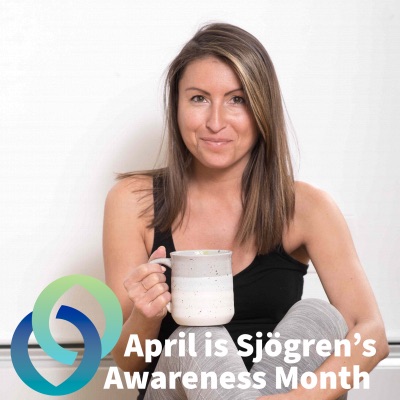
Ashelii 35 (diagnosed at 32)
It takes a lot to keep my motivation, because the second I feel great, some new pains/symptom pops up. But Sjögren’s has taught me that you can't give up. We are all on our own unique journey and it's okay to invest in our health.
Click here to learn about becoming a member of the Foundation.
Sjögren’s (SHOW-grins) is a systemic autoimmune disease that affects the entire body. Along with symptoms of extensive dryness, other serious complications include profound fatigue, chronic pain, major organ involvement, neuropathies & lymphomas.
April is Sjögren’s Awareness Month
Sjögren’s is one of the most prevalent but still lesser known autoimmune diseases. It is also not a “cookie cutter” disease and affects patients differently. This can lead to a misunderstanding about the seriousness of the disease and be extremely isolating for those living with it.
Using our new 2020 theme, we are going to expand our #ThisIsSjögrens online campaign. We will post every day in April, using one or more of our social media channels, to create a better understanding of the disease. While the daily posts will each give one small glimpse into living with Sjögren’s, by the end of April, we hope these 30 posts will help others visualize the vast impact of the disease. Click here if you would like to learn how to be one of our highlighted stories in April.
Help us conquer the complexities of Sjögren's this April because every day is an opportunity to start a conversation about Sjögren’s and how it affects you. The more others understand, the more support you can find.
Ways you can get involved:
Together we will conquer the complexities of Sjögren's!
30 Days of Sjögren's Awareness
Day 1:
April is Sjögren’s Awareness Month. Today, we invite you to update your Facebook profile picture with our Awareness Frame to help raise awareness of this complex and misunderstood disease. In today’s healthcare system, especially amid the COVID-19 crisis, it is even more important that we virtually come together to ensure that Sjögren’s patients are not forgotten.
Sjögren’s (SHOW-grins) is a systemic autoimmune disease that affects the entire body. Along with symptoms of extensive dryness, other serious complications include profound fatigue, chronic pain, major organ involvement, neuropathies & lymphomas.
Day 2:
It is with great pride that during Sjögren's Awareness Month, the Foundation can announce that we have officially changed our name, our logo, our look and our website! We have been asked for years to drop the word "syndrome" from our name and literature, and after a year-long project working alongside our board, medical & scientific advisors, patients and volunteers, we are excited to share with you our new logo and newly designed and rebranded website - www.sjogrens.org.
Day 3:
Katie 25 (diagnosed at 20)
My most difficult Sjögren's symptom that people don’t understand is fatigue. It’s not being tired. It’s your muscles refusing to work, your legs refusing to carry you around and your arms refusing to be raised up. Some people with Sjögren's will wake up with this fatigue, some develop it after a busy or stressful day, and for others, it hits us like a brick out of nowhere. We aren’t being lazy. It can be paralyzing. Click here to learn more about Sjögren's fatigue.
Day 4:
Kathy 55 (diagnosed at 53)
My most difficult Sjögren's symptoms are neuropathy, difficulty breathing, frequent bronchitis, extreme fatigue, hair loss, dry itching skin, and muscular/joint pain.
I wish that people knew that being handicap can look different. People stare when they see me with my handicap placard and I’d like them to know that it’s not because I can’t walk, it's because my lungs won't let me walk long distances. Click here to view from our Living with Sjögren's survey Summary of Major Findings.
Day 5:
Alyssa 29 (diagnosed at 16)
I truly felt the effects of Sjögren's when I became a mother. Despite a high-risk pregnancy because of Sjögren's antibodies, I now have a healthy, active toddler who I desire to keep up with.
I wish people knew that even though I always smile and seem like an active person, there are days where I am pushing through fatigue and joint pain. My best advice is to stay hydrated, bring awareness and try to have a positive mindset through it all.
Click here to learn more about pregnancy and Sjögren's.
Day 6:
Melissa 44 (diagnosed at 37)
When I was diagnosed with Sjögren's, my first thought was, what is Sjögren's? I had never heard of the disease. After my initial shock, I had had so many questions for my rheumatologist. I believe that when we are diagnosed with Sjögren's, we have a responsibility to educate others. We have to keep fighting.
Click here to learn more about living with Sjögren's.
Day 7:
Jaeden 10 (diagnosed at 6)
I’m a kid that just wants to have a normal life. When I’m out with friends or family the extra breaks and carrying around extra water gets annoying. I wish more people and schools were more educated on Sjögren’s to understand me better. This is something that isn’t going away and every day is different.
Click here to learn more about Sjögren's in children.
Day 8:
Sherry 72 (diagnosed at 72)
I was recently diagnosed with Sjögren’s from a lip biopsy, after my serum test were always negative. I’m thankful to finally have a diagnosis because my various symptoms like neuropathy and dry skin make sense, but my diagnosis is new and due to COVID-19, I can’t see a rheumatologist until medical offices are opened again.
Click here to learn more about how Sjögren's is diagnosed.
Day 9:
Abby 22 (diagnosed at 22)
My most difficult Sjögren’s symptoms are fatigue, frequent fevers and a painful malar rash on my face. My rheumatologist suggested I try a restrictive autoimmune protocol diet, which helped me learn what foods trigger me and my symptoms.
Click here to view the Foundation’s Book Store and view more Sjögren’s resources.
Day 10:
Ray 55 (diagnosed at 43)
Since I was diagnosed with Sjögren’s, I have learned that I can still be me and enjoy my life! My most difficult symptoms are peripheral neuropathy, fatigue, dry mouth and dry eye. I cope with this disease by taking “me” time when I need it, medication as directed by doctor, and keeping my medical appointments. My best advice is to set personal goals and keep them, but don’t overdo it. Click here learn more about Sjögren's in men.
Day 11:
Ana 43 (diagnosed at 23)
I wish people understood that just because I look "normal," internally, I am fighting a battle with a multi symptom disease.Every day is a struggle to gather energy and live a life, as best as I can.
Click here to learn more about Sjögren’s symptoms.
Day 12:
Katie 31 (diagnosed at 28)
Sjögren’s is so much more than dry mouth and dry eye. There is no roadmap for how the ugly symptoms can present themselves. I wish people took this disease more seriously. It can be so painful and isolating.
Click here to learn more about Sjögren’s.
Day 13:
Betty 66 (diagnosed at 55)
I first went to my doctor because I had a charley horse one night that was so bad, I couldn’t sleep. I went to my doctor who said my antibody was positive and then sent me to a rheumatologist who did a lip biopsy, which led to my diagnosis. I take my prescribed medications and have learned that I can live a normal life, but I am still in pain most of the time.
Click here to learn more about living with Sjögren’s.
Day 14:
Janell 55 (diagnosed at 26)
Sjögren’s means that I’m always at some type of doctor and wonder every day how I’m going to feel when I wake up. My best tip is to know your body and have a support system like a Sjögren’s Foundation Support Group.
Click here to learn more about Foundation Support Groups.
Day 15:
Laura 47 (diagnosed at 42)
My most difficult Sjögren's symptom is the tooth decay. I’m always aware and self-conscious of my mouth when I talk and try to cover it whenever I laugh. My biggest fear with COVID-19 is that there is an extended shortage of Hydroxychloroquine/Plaquenil and autoimmune patients become collateral damage.
Click here to learn more COVID-19 updates from the Sjögren's Foundation
Day 16:
Joan 24 (diagnosed at 20)
Sjögren's has taught me how to be an advocate. I learned that I need to be my own best advocate in medical appointments, when I was in college, at work and I have learned that I need to be an advocate for all patients living with this disease. My best tip is to not take the good days for granted and when you’re having a harder time (in a flare) be kind to yourself. It’s okay to not accomplish everything on your to do list.
Click here to learn more Sjögren's tips.
Day 17:
Chris 30 (diagnosed at 25)
Since being diagnosed with Sjögren's, I have learned that there is no right answer for this disease. Just when you think you have a symptom under control, something new pops up that you've never experienced. We are in this together!
Click here to learn more about becoming a member of the Sjögren's Foundation.
Day 18:
Billie 44 (diagnosed at 40)
Currently, I am medically quarantined per doctor’s orders. I have been hospitalized seven times for pneumonia illnesses in the past, including one time in the ICU. Sjögren’s taught me that I am tougher than I ever thought I was, but I am afraid for my safety if I were to contract COVID-19.
Click here to view the Foundation’s response to the Coronavirus.
Day 19:
Emily 33 (diagnosed at 32)
My most difficult Sjögren’s symptoms are joint pain (especially in my hands), brain fog and fatigue. I love gardening and now I use assistive tools that make it more comfortable. I’ve found a lot of help in sharing tips and product suggestions with other patients.
Click here to learn more about how to get involved in the Sjögren’s Foundation community.
Day 20:
Johanna 40 (diagnosed at 39)
About a year before my diagnosis I noticed that I was chronically fatigued. I work long hours and brushed the symptom off, but it eventually got to the point where it was difficult to get out of bed. Being in the medical field, I knew something was wrong with my body. There are going to be dark frustrating days when living with disease. I encourage all of my Sjögren’s brothers and sisters out there to stay positive. Don’t ever give up!
Click here to learn more about Sjögren’s treatment options.
Day 21:
Amanda 30 (diagnosed at 28)
I was diagnosed with Sjögren’s after being hospitalized for 10 days (admitted for aseptic meningitis and uveitis). I find that so much is out of our control when living with this disease. My best tip is to find a really good healthcare team - don't settle! Your health is in their hands. It's important you feel like you're receiving current, compassionate and research-based care.
Click here to learn more information if you are newly diagnosed.
Day 22:
Inonge 58 (diagnosed at 54)
My most difficult Sjögren’s symptoms are chronic pain, fatigue, brain fog and body swelling. Due to scalp sensitivity, I’m unable to wear a wig and have been forced to accept the new me with alopecia. I have lost a lot because of this disease, which has taught me to focus on the things that really matter.
Click here to learn more about living with Sjögren’s.
Day 23:
Jannalee 31 (diagnosed at 25)
I wish people knew that just because they can’t physically see the symptoms, it doesn’t mean we aren’t struggling. My best tip is that saying “no” is ok. People may not understand why I say no to certain events, but that’s okay. They aren’t living my life. If I overexert myself, I can’t function the next day and I don’t want to live like that. I want to embrace every day! Make time for things you enjoy and for me, that’s running.
Click here to learn more about the Foundation’s Team Sjogren’s Running Program.
Day 24:
Kelsey 24 (diagnosed at 21)
My most difficult Sjögren’s symptoms include fatigue, widespread muscular and joint pain, dryness, neuropathy, hair loss, frequent colds, brain fog and vertigo. I believe that the largest misconceptions of Sjögren’s is the severity of this SYSTEMIC disease. It can affect every single system of the body and is different from person to person.
Click here to learn more about Sjögren’s.
Day 25:
Susan 60 (diagnosed at 45)
It took me a while to be diagnosed with Sjögren’s because it can mimic other autoimmune disease. I wish people knew that when I speak and sound hoarse, it's because of Sjögren’s and not that I'm catching a cold or getting sick.
Click here to learn more about patient support town hall virtual meetings.
Day 26:
Tiffany 33 (diagnosed at 20)
My most difficult symptoms are chronic fatigue, inflammation, frequent headaches, vision issues, severe dry eyes, neuropathy, muscle weakness and pain. I wish people understood that going on a diet and getting more exercise is not a cure. Yes, those things can help but it’s not a cure. If it was that simple, I would have been cured a long time ago. Some days I feel pretty good and can handle my symptoms. Other days, I feel like I’m dying.
Click here to view frequently asked questions about Sjögren's.
Day 27:
Ayyu 37 (diagnosed at 35)
I used to “power through” symptoms because I have a high pain tolerance, but Sjögren’s has taught me that I need to listen to my body. I have also learned to be kinder to myself both mentally and physically. A positive attitude is key.
Click here to view Sjögren’s Foundation resources.
Day 28:
Trista 32 (diagnosed at 29 but symptomatic since childhood)
Sjögren’s means that you have to become your biggest advocate. I found that educating yourself is a necessity. One of my favorite resources is "The Sjögren’s Book" by Daniel J. Wallace.
Click here to learn more about "The Sjögren’s Book.”
Day 29:
Tasha 46 (diagnosed at 5)
I was very sick as a child, but my parents taught me to be tough. My best tip is the advice I received from my father when I was 5. “You can do this. You can live with this.” Sjögren’s patients have to be strong. We can handle this TOGETHER!
Click here to learn more about free community Zoom calls from the Sjögren’s Foundation.
Day 30:
Ashelii 35 (diagnosed at 32)
It takes a lot to keep my motivation, because the second I feel great, some new pains/symptom pops up. But Sjögren’s has taught me that you can't give up. We are all on our own unique journey and it's okay to invest in our health.
Click here to learn about becoming a member of the Foundation.
Sjögren’s (SHOW-grins) is a systemic autoimmune disease that affects the entire body. Along with symptoms of extensive dryness, other serious complications include profound fatigue, chronic pain, major organ involvement, neuropathies & lymphomas.